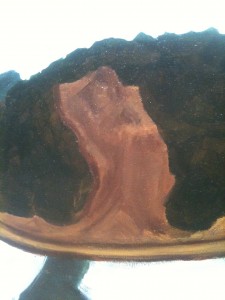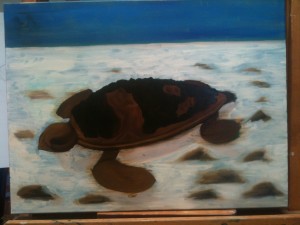|
The day’s painting was in some ways frustrating. I had to undo what I had already done, once I had colour-matched it. I need to paint the sea floor before I paint the sea surface, as the turtle is swimming in comparatively shallow waters. This means a white sea floor with dark rocks.
I started by bringing the shell to a finished or near-finished state:
 This started with splodges of my ever-favourite Terre de Cassel, a dark slightly greenish brown. In the picture you can see the shadow is a mix of sap green and Terre de Cassel, and has a high transparency. TdC is good at tinting other colours. Each shell section was marked out regularly. To that I added ochre and a variety of other browns in earth tones. Most brown paint is made by grinding earth or rocks that have been baked to a greater or lesser degree. Off the top of my head, Cassel, Sienna, and Umber are all distinctive earth types named after places, and as you cook them they get darker. Ochre is yellowish and goes brown as you cook it, until it looks a bit like raw sienna if you squint. This started with splodges of my ever-favourite Terre de Cassel, a dark slightly greenish brown. In the picture you can see the shadow is a mix of sap green and Terre de Cassel, and has a high transparency. TdC is good at tinting other colours. Each shell section was marked out regularly. To that I added ochre and a variety of other browns in earth tones. Most brown paint is made by grinding earth or rocks that have been baked to a greater or lesser degree. Off the top of my head, Cassel, Sienna, and Umber are all distinctive earth types named after places, and as you cook them they get darker. Ochre is yellowish and goes brown as you cook it, until it looks a bit like raw sienna if you squint.
In this case the burned sienna was too red, and I had to take off the layer in the area I had applied it. However, I eventually had, once I had blurred the edges, a mountainous shell-like appearance. I did the same thing but in smoother lines for the head, formed the beak with a finer brush, and added a little highlighting to the eye.
Then I addressed the seabed:
 I was on a coral beach once, and the sand was amazingly white. It was strange to think of so much parrot-fish poo being romantic, but given what flowers really are, I can live with sitting on the extruded indigestible parts of more coral than you can shake a very big stick at. However, white is a colour that is hard to disguise. If you do not tint it, then it has an awful tendency to shine through things. I mixed in just a little yellow, painted all the rocks including their shadows, and then filled in the sea bed. I left a hint of the shadow of the turtle, but it would be less clear than the shadows of the rocks. I was on a coral beach once, and the sand was amazingly white. It was strange to think of so much parrot-fish poo being romantic, but given what flowers really are, I can live with sitting on the extruded indigestible parts of more coral than you can shake a very big stick at. However, white is a colour that is hard to disguise. If you do not tint it, then it has an awful tendency to shine through things. I mixed in just a little yellow, painted all the rocks including their shadows, and then filled in the sea bed. I left a hint of the shadow of the turtle, but it would be less clear than the shadows of the rocks.
Then, I blurred everything that would be underwater, and added distortions to the parts that will be at the surface. I used a hog hair fan brush, and swept it across the canvas along the length of its arc, so the hairs would support each other. Then I put in more highlights on the eye because the turtle was looking at me and that was creepy. That was my day.
|